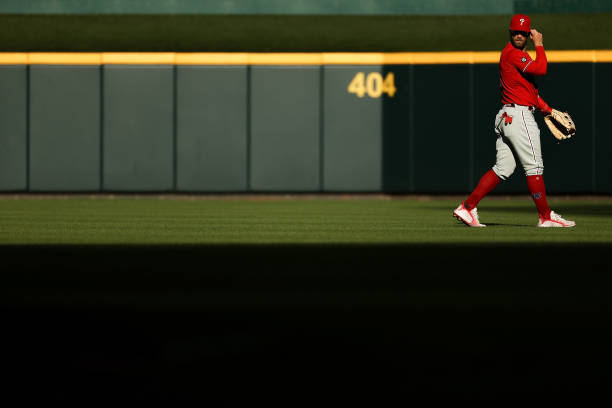
The Philadelphia Phillies are having yet another year of fringe contention and overall mediocrity. They currently sit in fourth place in the National League East, with a record of 36-39. Their position is rather unsurprising considering their near-identical play over the last three-plus seasons, but they are still underperforming even the most modest projections. At this rate, they will finish the season at around 77-85, good for a .475 win percentage. Essentially, the Phillies have been and will likely continue to hover around .500. This is the exact definition of mediocrity, a team that fails to climb any higher than .500. So it is that the Phillies are for all intents and purposes a mediocre team at best.
Recent History of Mediocrity
While some could argue that the Philadelphia Phillies have been mediocre if not downright awful for their entire 138-year existence (and they would be right), the recent string of mediocre seasons started in 2018. After the big signings of Carlos Santana and Jake Arrieta, the Phillies seemed poised to trot back to contention. They in fact played reasonably well, holding first place all the way until the beginning of August of that year. However, the Phillies fizzled in the final two months of the season and suffered their yearly September collapse. They finished the 2018 season with a lackluster record of 80-82, good for third place in the division.
In 2019, the Phillies decided that they were on the cusp of contention, so they went on a spending spree. Many will recall Phillies’ principal owner John Middleton saying that his team was going to spend “stupid money.” Well, it seems that he was not kidding as the Phillies spent more than $475 million to bolster their core. It started with a trade for Jean Segura and the signing of Andrew McCutchen for more than $50 million. Then the Phillies traded for All-Star catcher J.T. Realmuto from the Miami Marlins and signed marquee free agent Bryce Harper to what was then the largest contract in baseball history (13 years, $330 million).
However, all of these moves were still not enough to propel the Philadelphia Phillies. They finished the season with a record of 81-81, just a one-game improvement from the previous year. At that point, Middleton had enough of manager Gabe Kapler and fired him shortly after the end of the season. He was replaced by veteran manager and former Yankees skipper Joe Girardi.
With Girardi on board and the free-agent signings of Zack Wheeler and Didi Gregorius, there was renewed hope in Philly that maybe the 2020 season would be different. Then the coronavirus pandemic hit and the entire baseball calendar was essentially thrown out. Eventually, a shortened 60 game season began at the end of July. While the Phillies were afflicted by the target=”_blank” rel=”noopener”pandemic directly (they missed more than a week near the beginning of the season), there were still relatively high expectations for their club. But old habits die hard and the Phillies again stumbled their way to a mediocre season. What really angered fans though was that the Phillies only needed to win one of their last three games against the Tampa Bay Rays to make the playoffs. However, they proceeded to lose all three and miss the playoffs with a record of 28-32, again finishing third in the division.
The Roots of Mediocrity
To truly understand why the Phillies have disappointed year after year, the root causes of their struggles must be explored. First, we must go back to 2018 when they first started to sign free agents to big-money contracts. The Phillies were not nearly good enough to warrant the free-agent expenditures to vault them into contention. They had not drafted well enough or acquired players in trades that could help them in the short term. The result was augmenting a team that was still essentially rebuilding. So, the outcome was an overall weak team that was overly dependent on veteran players.
In 2018, the only players that could be considered homegrown cornerstones were pitcher Aaron Nola and first basemen Rhys Hoskins. A team, no matter how well constructed, can not expect to compete if they only have two homegrown star-caliber players. And while many other players were solid contributors (Odubel Herrera, Cesar Hernandez, Zach Eflin), none were true superstars or cornerstones. So the Phillies, right from the outset of their rebuild, dug themselves a hole.
Another cause of the Philadelphia Phillies’ continued mediocrity is their downright pathetic drafting and player development systems. Outside of the aforementioned Nola and Hoskins, no homegrown Phillie has given the Phillies consistent or star production. In fact, none of the Phillies’ first-round picks in the last decade outside of Nola have made an All-Star team. This includes top ten picks Cornelius Randolph (2015), Mickey Moniak (2016), Adam Haseley (2017), or Alec Bohm (2018). And it seems that only the currently struggling Bohm will ever be capable of making an All-Star team.
For the Phillies, the truth is sad, a team that has so much potential but can never capitalize on it because of never having enough young talent coming through the system. On this note, it should be said that a plethora of players that never had success with the Phillies are now having career seasons on other teams. These include Red Sox pitcher Nick Pivetta and Athletics pitcher Cole Irvin. Both of these players disappointed while with the Phillies, but now are sturdy contributors with their new teams. The Phillies just do not seem to be able to develop the best possible versions of their prospects. The result is players vastly outperforming their career numbers while in Philadelphia with other teams.
The Phillies documented misfires at the last three trade deadlines have also helped to keep them mediocre. In 2018, they traded for several veterans including Asdrubal Cabrera, Justin Bour, and Wilson Ramos to name a few. None of these players panned out and the Phillies ended up disappointing. In 2019, they added Corey Dickerson from the Pirates who essentially replaced the injured Andrew McCutchen in left field. While Dickerson was productive with the Phillies, this move alone was not enough to propel the team and they again ended up mired in mediocrity.
Then came 2020, perhaps the Phillies’ worst deadline in recent memory and the cause for former GM Matt Klentak’s firing. The Phillies acquired four relievers to try to patch up what was one of the worst bullpens in history. The result was Klentak trading for Red Sox relievers Brandon Workman and Heath Hembree, Yankees’ long man David Hale, and Brewers’ reliever David Phelps. The outcome could not have been more disastrous, as all four relievers struggled mightily and the Phillies ended up missing the playoffs for the ninth consecutive season.
Where the Phillies Go From Here
Through 75 games, the 162 slug that is the baseball schedule is far from over. But if the Phillies want to avoid the mediocrity that plagues them, they need to start taking productive steps. First, they need to determine whether they are buyers or sellers at this years’ deadline. If the Philadelphia Phillies are below the .500 Mendoza Line at the July 30 deadline, they need to strongly consider planning for the future and dealing some of their veteran assets. While they are thin on young talent, the Phillies have plenty of veterans who may be attractive to other teams (Andrew McCutchen, Odubel Herrera, Jean Segura, Vince Velasquez, and Archie Bradley to name a few).
If however, they are in the playoff hunt for the division come July 30, the Phillies should make a play for an impact bat or reliever. With that, they should be targeting players such as Rockies’ shortstop Trevor Story and Brewers’ closer Josh Hader. Only players in that category will be enough to lift the Phillies to their first playoff series in a decade. But they should only consider adding them if they are legitimately contending for the playoffs.
Looking longer-term, the Philadelphia Phillies need to strongly consider retooling or rebuilding their roster around Bryce Harper and J.T. Realmuto if this season does not end with a playoff birth. Perhaps trading pieces such as Hoskins and Eflin would be smart if the Phillies decide to go this route. These players will be due substantial pay raises in the very near future as well, so the logic is sound. Then with their expanded financial flexibility and desire to win, the Phillies could make a play for some of the premier free agents in the coming free-agent period. These could include shortstops Corey Seager, Carlos Correa, or Javier Baez. It could also include starting pitchers Justin Verlander, Max Scherzer, or Clayton Kershaw. The Phillies would also be wise to try to build from within and avoid giving up their most valuable assets.
2021 Outlook
It seems certain that in order to make the playoffs, the Phillies are going to need to win their division. This is necessary because there will only be two wild cards, unlike last season. Also, other National League teams may be in a better position to secure those seeds. The Padres, Dodgers, and Giants are all playing very well this season, but only one can win the division. Assuming the currently leading Giants secure it, the other two teams will likely be left with the two wild cards considering they are both well over .500 at this point.
This means that the Phillies’ only realistic hope to making the playoffs this year is to win their division. The good news is that they are currently only five games back of the Mets for first place. Unfortunately for the Phillies, it still will likely take between 88 and 90 wins to secure the NL East. This means that the Phillies would need to go 52-35 to get there. How likely is that to happen considering the Phillies’ current lackluster play? It seems that the Philadelphia Phillies are destined for yet another disappointing season, as well as another chapter to add to their chronicle of perennial mediocrity.
Main Photo:
Embed from Getty Images










